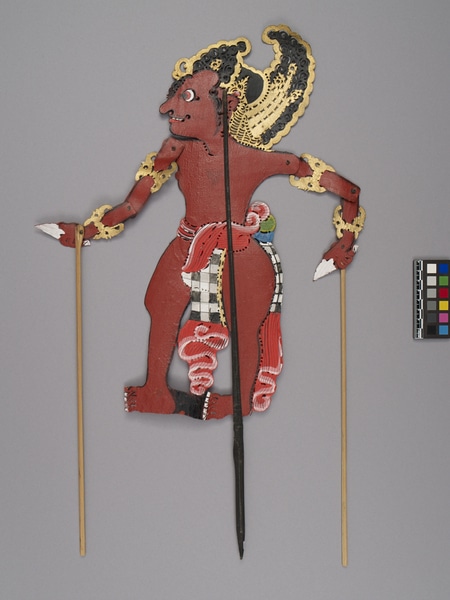Shadow Puppet Item Number: 2897/17 from the MOA: University of British Columbia

Description
Shadow puppet, representing the character Bima, Pandhawa Prince, made of skin. The figure wears a large gold and black headdress. The headdress has decorative holes cut into it and scalloped edges to mimic fine metalwork. The figure’s flesh is dark red. His face is in profile and looks to the left. He has a long black sideburn and a small black moustache. The figure’s eyes and tongue are red. His chest is bare and has a small patch of chest hair. On each of the figure’s upper arms and forearms he wears gold bracelets. In each of his hands he holds a white spear. Each of his arms is composed of an upper arm piece, a forearm piece and a hand piece of skin. These pieces are attached to each other using small nails. His wrist joints are also attached to long wooden sticks; this results in his arms having movable joints. Tied around his waist, the figure wears a loin cloth. The fabric is red, black, grey, white, blue and green. The red, green and blue elements of the garment have black stripes on them. The black, grey and white elements of the garment are arranged in a check pattern with gold trim. The puppet’s thighs are large and bare. Black thread attaches a wide wooden stick to the middle of the puppet’s body. The stick is pointed at the bottom end.
History Of Use
Wayang kulit was established on Bali, when the Hindu Majapahit Court moved there in the 16th century, from neighbouring Java, after the first Islamic sultanate had been established. A dynamic living art, over the centuries, Balinese wayang kulit has developed its own distinctive aesthetic, with more realistic looking human characters. The stories performed are frequently drawn from the Mahabharata, with an extensive cast of gods, heroes, villains, ogres and demons.
Iconographic Meaning
The use of colour is highly symbolic: it communicates the personalities and qualities of the puppets. Kresna (an avatar of Wisnu) is first painted white to characterize his spiritual purity, and then painted either green or blue, which symbolizes intelligence, harmony and courage. In contrast, Bima, the second Pandhawa brother, is painted red; a colour associated with tempestuousness, boldness and strength.
Item History
- Made in Bali, Indonesia during 2000
- Collected during 2000
- Owned by Kenneth Dent before June 29, 2011
- Received from Kenneth Dent (Donor) on June 29, 2011
What
Who
- Culture
- Balinese
- Previous Owner
- Kenneth Dent
- Received from
- Kenneth Dent (Donor)
Where
- Holding Institution
- MOA: University of British Columbia
- Made in
- Bali, Indonesia
When
- Creation Date
- during 2000
- Collection Date
- during 2000
- Ownership Date
- before June 29, 2011
- Acquisition Date
- on June 29, 2011
Other
- Condition
- good
- Accession Number
- 2897/0017